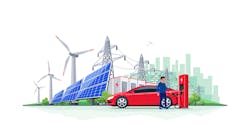‘New Energy,’ Grid Modernization and Decarbonization Drive Electric Industry to Repower
From the need to better integrate renewable energy into the grid to ensuring increased resilience and reliability while pursuing a lower-carbon footprint, electric utilities are pressing to transform themselves into an ever-evolving, complex energy ecosystem. Black & Veatch's new 2020 Strategic Directions: Electric Report details these drivers and provides insight into the most effective way for the electric industry to respond.
The global engineering, consulting, procurement and construction (EPC) company's survey of more than 600 electricity industry stakeholders offers deep perspective on a power sector where "new energy" in the form of renewables drawn from solar and wind, both on land and increasingly offshore, continues to accelerate. Calls for decarbonization from corporations, activists, shareholders, states, and nations are increasing, fueling the need for utilities to balance energy portfolios in a move toward cleaner, more environmentally friendly options.
Key insights for 2020 include:
- New regulations are creating new dynamics — traditional methods of operating a power utility with separate generation, transmission and distribution (T&D) assets are giving way to more integrated approaches.
- Electric vehicles (EVs) and electrified fleets are gaining traction as vehicle production and delivery intensifies, requiring power providers to meet charging needs as increasingly empowered consumers — both citizens and commercial and industrial interests — test utilities' business models.
- New power generation technologies harnessing green hydrogen produced through renewable power and more advanced battery storage show growing promise in the quest for decarbonization.
- Climate change, COVID-19, and shifting demographics highlight an industry where there's no one-size-fits-all dynamic and management of the grid is becoming more targeted and localized.
"After 130 years, the power industry is being repowered as sweeping changes are guiding more focus on a consistent, methodical adoption of innovative practices to ensure the sector's relevance," said Mario Azar, president of Black & Veatch's power business. "Now more than ever, consumers expect their power providers to be progressive and proactive, further emphasizing the need for reliable and resilient energy supplies."
Other notable findings in the report include:
- Aging infrastructure remains the chief concern among one-third of respondents, down 13 percentage points from a year ago. But renewables remained the secondary focal point, relatively unchanged from 2019 at more than one-quarter of the survey-takers.
- More than three-quarters of respondents agree that they are devoting more of their capital spending to clean energy.
- 8 of 10 respondents forecast that over the next five years, more of their spending in new generation capacity will be directed at solar arrays on land, followed closely by energy storage and eventually microgrids and other distributed energy resources (DERs).
- Nearly one-quarter of respondents say they would consider hydrogen as a source of peak generation.
- When asked which elements of DERs are most challenging, two-thirds of respondents cited the ability to forecast, monitor, and manage utility-owned and third-party DERs.
- 68% of respondents are working to redesign their regulated rate and pricing structures to accommodate an increased penetration of DERs.
- The percentage of respondents who consider electrified transportation as a big opportunity to gain future load and revenue spiked 74% over 2019, to 21% from just 12%.
A copy of the report is available for download here.
